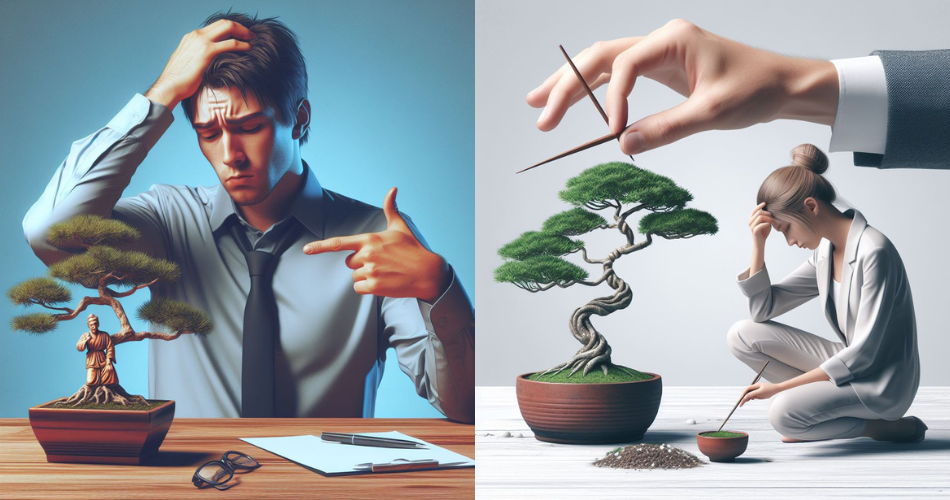
Bonsai cultivation is a challenging and rewarding art that requires patience, dedication, and knowledge. As a bonsai enthusiast, I have learned that mistakes are an inevitable part of the learning process. In fact, making mistakes is essential to improving your skills, as it allows you to identify weaknesses and areas for improvement.
In this article, I will share my insights and experience on some of the most common bonsai mistakes and provide guidance on how to navigate them successfully. From selecting the right tree species to pruning, wiring, soil composition and watering frequency, there are a variety of practices that can lead to mistakes. By understanding these mistakes and how to avoid them, you can take your bonsai cultivation to the next level.
Key Takeaways
- Mistakes are an essential part of the bonsai learning process
- 10 common bonsai mistakes include over-pruning, incorrect branch selection, improper soil composition, under and over-watering, and watering frequency
- Understanding bonsai basics like species selection and pruning techniques is crucial to success
- Proper bonsai soil and watering are vital for a healthy, growing tree
- Patience, practice and a willingness to learn will help you navigate bonsai mistakes like a pro
Understanding Bonsai Basics
As I continue this journey in bonsai cultivation, let’s get to the root of what makes a bonsai thrive. Understanding Bonsai Basics is key if you want to create and maintain a healthy and beautiful plant.
Selecting the right tree species
Not all trees are ideal for bonsai. Choose species that are hardy, small-leaved, and easy to maintain for a beginner. Consider the needs of the tree and its adaptability to the environment.
The importance of soil and watering
Bonsai soil must be a well-draining mix that doesn’t hold too much water. Be mindful of when the plant needs watering, and avoid watering during extreme weather conditions. A thorough watering every one to two weeks should suffice.
The role of pruning and wiring in shaping a bonsai tree
Regular pruning encourages the plant’s growth, shape and structure. Wiring can be used to bend branches and shape the tree as it grows. These techniques should be used with care and caution, as over-pruning can lead to a weakened and unhealthy tree.
“Bonsai is not a race, it’s a journey. Enjoy the process and learn from your mistakes.” – Kathy Shaner
Avoiding Common Pruning Pitfalls
Correct pruning is critical to shaping a bonsai tree and maintaining its health. However, novice bonsai enthusiasts often make mistakes when it comes to pruning. Some of the most common pruning mistakes include:
- Over-pruning, which can weaken the tree and damage its structure
- Choosing the wrong branches to prune, which can result in an imbalanced appearance
- Pruning at the wrong time of year, which can cause stress to the tree and lead to slower growth
To avoid these pruning pitfalls, it is essential to have a clear understanding of the specific needs of your bonsai species. Regular observation and assessment of the tree’s growth patterns can help you determine the appropriate pruning timing and techniques. Remember to only prune as much as necessary, selecting branches that will enhance the tree’s overall appearance and avoiding excessive cutting that can harm the tree.
Pro tip: Be patient in your pruning efforts, as it can take time to see the full effects of your work. Always err on the side of caution, and stop pruning before you do permanent damage to the tree.
“When pruning, always keep in mind the balance of the overall tree structure. Don’t be afraid to visualize the final shape and carefully plan your cuts.”
Troubleshooting Soil and Watering Mistakes
When it comes to growing a healthy and beautiful bonsai tree, the right soil composition and proper watering techniques are essential. Unfortunately, novices often struggle with these aspects, leading to soil and watering mistakes that can harm the tree’s health and growth. In this section, I’ll explore the most common soil and watering mistakes in bonsai cultivation and provide practical solutions to overcome them.
Soil Composition Mistakes
One of the most significant mistakes novice bonsai enthusiasts make is using the wrong soil composition. Many people think that any type of soil will work for a bonsai tree, but this is not the case. The roots of a bonsai tree need proper nutrition, aeration, and drainage to grow and thrive, which means the soil composition must be carefully selected. Common mistakes include using regular potting soil or garden soil that is too heavy and dense, or using soil that lacks essential nutrients.
To avoid soil composition mistakes, it’s crucial to select the appropriate bonsai soil mix. A good bonsai soil mix typically consists of components like akadama, pumice, and lava rock, which provide the ideal balance of aeration, drainage, and moisture retention. Beginner bonsai enthusiasts can use pre-mixed bonsai soil, which is readily available at nurseries and garden centers, to avoid making soil composition mistakes.
Under-Watering and Over-Watering
Another common issue with novice bonsai enthusiasts is under-watering or over-watering the tree. Both of these mistakes can be detrimental to the tree’s health, leading to root rot or dehydration.
Under-watering is more common in the summer months and occurs when the soil becomes too dry. Signs of under-watering include wilted leaves, dry soil, and yellowing of the foliage. To avoid under-watering, ensure that the soil remains moist and regularly check the tree’s water requirements, particularly during hot weather.
Over-watering, on the other hand, is more common in the winter months when the tree’s water requirements are lower. Over-watering happens when the soil becomes too saturated and the tree’s roots don’t receive enough oxygen. Signs of over-watering include yellowing or browning of the leaves, mold or fungus growth, and a foul smell. To avoid over-watering, it’s important to water the tree only when the soil has completely dried, and ensure proper drainage to prevent the soil from becoming too compact.
Frequency of Watering
Finally, another common mistake is watering the tree too frequently or infrequently. The frequency of watering depends on factors like the tree species, soil composition, and weather conditions, and can vary significantly.
As a general rule, it’s essential to water the tree when the soil is dry to the touch, but not bone dry. However, each tree’s water requirements can differ, and it’s essential to learn to read your tree and adjust the watering frequency accordingly.
Bonsai Mistakes Conclusion: Navigating Bonsai Mistakes Summary
Throughout this article, I have discussed the art of bonsai and how mistakes can be a natural part of the learning process. It’s important to remain patient and stay committed to learning from our mistakes as we navigate the world of bonsai cultivation.
We covered 10 common bonsai mistakes that novice enthusiasts often make, including problems related to watering, soil composition, pruning, and wiring. By understanding these common pitfalls, we can avoid making the same mistakes and begin to grow healthy, vibrant bonsai trees.
Remember, bonsai cultivation takes time and practice. While it can be frustrating to encounter setbacks, it’s important to view these moments as opportunities to learn and improve. By embracing a growth mindset and remaining committed to the process, we can develop a deep appreciation for the beauty and artistry of bonsai cultivation.
Thank you for taking the time to learn more about bonsai and how to navigate common mistakes. I hope this article has been helpful and informative, and that it inspires you to continue exploring this ancient artform for years to come.
FAQ
What is bonsai?
Bonsai is a traditional Japanese art form involving the cultivation and shaping of miniature trees in pots. It is a meticulous practice that requires careful attention to detail and artistic vision.
Are mistakes common in bonsai cultivation?
Yes, mistakes are an inevitable part of learning and growing as a bonsai enthusiast. They can occur at any stage of the bonsai cultivation process, but with the right knowledge and guidance, they can be navigated successfully.
What are some common bonsai mistakes?
Some common bonsai mistakes include over-watering, incorrect pruning techniques, improper soil composition, and selecting the wrong tree species for a specific climate.
How can I navigate bonsai mistakes?
Navigating bonsai mistakes requires patience, practice, and a willingness to learn from your errors. It is essential to educate yourself about the basic principles of bonsai, seek guidance from experienced bonsai growers, and embrace the process of experimentation and refinement.
What are the fundamentals of bonsai?
The fundamentals of bonsai include selecting the right tree species, understanding the importance of soil and watering, and mastering pruning and wiring techniques to shape and maintain a bonsai tree’s aesthetics.
What are some common pruning mistakes in bonsai cultivation?
Some common pruning mistakes in bonsai cultivation include over-pruning, selecting improper branches to remove, and pruning at the wrong time of year. These mistakes can impact the overall health and shape of the bonsai tree.
How can I avoid pruning pitfalls in bonsai cultivation?
To avoid pruning pitfalls, it is crucial to study proper pruning techniques, understand the appropriate timing for pruning different tree species, and gradually refine your skills through practice and observation.
What are the challenges related to bonsai soil and watering?
Bonsai soil and watering present challenges such as improper soil composition, under-watering, over-watering, and determining the right frequency of watering. These factors significantly impact the health and growth of a bonsai tree.
How can I troubleshoot soil and watering mistakes in bonsai cultivation?
Troubleshooting soil and watering mistakes involves understanding the specific needs of the tree species you are cultivating, using well-draining bonsai soil, monitoring soil moisture levels, and adjusting watering practices accordingly.

